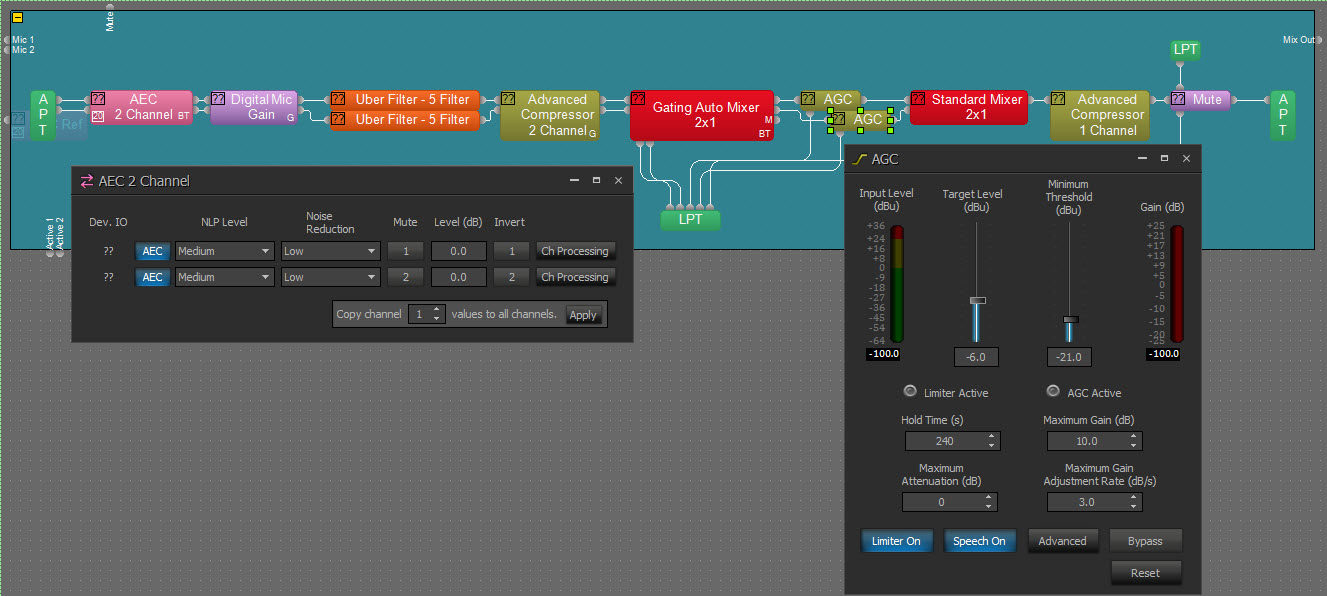Parlé Processing
The Parlé Processing block allows for easier configuration of a system to work with Parlé microphones.
Initialization Dialog
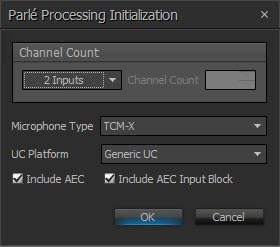
| Name | Description |
| Channel Count | Specifies the number of channels in the block. |
| Microphone Type | Choose microphone type from the dropdown. |
| UC Platform |
Choose the Unified Communications (UC) platform used in the room. If the platform used in the room is not listed, choose 'Generic UC'.
|
| Include AEC | AEC is included as part of the Parlé Processing Block. |
| Include AEC Input Block | AEC Input block is included as part of the Parlé Processing and AEC Ref blocks. |
Parlé Processing blocks placed in Tesira 3.15 or earlier (referred to as a "Legacy Parlé Processing block") cannot be edited to change the Microphone Type or UC Platform. To change these attributes, the user must delete the existing "Legacy Parlé Processing block" and replace it with a new Parlé Processing block. This restriction on editing the Microphone Type and UC Platform does not apply to Parlé Processing blocks placed in Tesira 3.16 or newer:
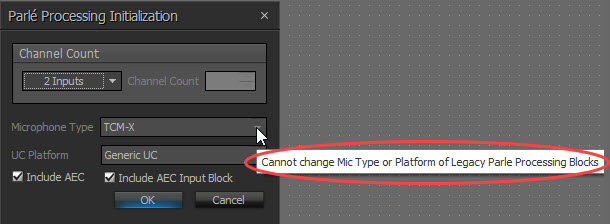
DSP Block Representation
Parlé Processing with 2 Channels:
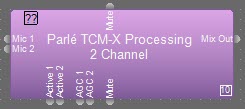
See this link for logic chart.
Control Dialog
The Parlé Processing control Dialog allows the user to set the acoustic quality of the room to optimize the sound of the microphone(s):
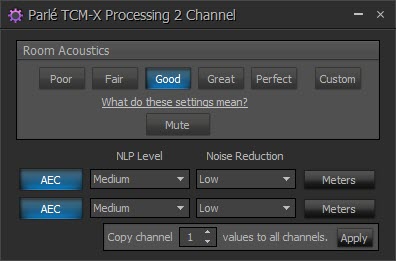
NOTE: AEC controls are included to further fine-tune the room.
|
Room Acoustics |
Noise Floor | Reverb Time (RT60) | Max. Mic-to-Talker Distance | ||
|
TCM-1 |
TCM-X |
TTM-X |
|||
| Poor |
more than 45 dBA |
more than 1000 ms |
1.5 meters (5 feet) |
1.8 meters (6 feet) |
1 meter (3.3 feet) |
|
Fair |
39-45 dBA |
500-1000 ms |
2 meters (6.5 feet) |
2.3 meters (7.5 feet) |
1.3 meters (4.3 feet) |
|
Good |
37-39 dBA |
400-500 ms |
2.4 meters (8 feet) |
3 meters (10 feet) |
1.7 meters (5.6 feet) |
|
Great |
35-37 dBA |
300-400 ms |
3 meters (10 feet) |
3.8 meters (12.5 feet) |
2.1 meters (6.9 feet) |
| Perfect |
less than 35 dBA |
less than 300 ms |
4 meters (13 feet) |
5 meters (16.3 feet) |
2.5 meters (8.2 feet) |
| Custom |
|
|
|||
These settings correspond with those available in the Parlé microphone coverage calculators available at the following links:
| Name |
Description |
Range |
| Mute | Turns the input signal off for all microphones. | On or Off |
|
*AEC |
Enables and disables the AEC processing chain. | |
|
*NLP Level |
Non-Linear Processing (NLP) is a stage of the Acoustic Echo Cancelation (AEC) process designed to eliminate residual echo in reverberant rooms with high RT60 times. While setting NLP 'high' may reduce echo in these rooms, it has a negative effect on double talk. Typically the lowest possible NLP setting to eliminate echo achieves the best system performance. A good practice is to start with a low setting and work upwards till echo can be no longer heard. |
|
|
*Noise Reduction |
Reduces steady-state background noises, such as HVAC systems, fans, motors, or other mechanical devices, that may be picked up by the conferencing microphones and transmitted to the far end. Use the lowest setting that achieves the desired level of background noise reduction. |
|
| *Meters | Include AEC | AEC is included as part of the Parlé processing. |
*Only if 'Include AEC' is selected at initialization.
AEC Reference
The AEC Reference Block will function the same as if the AEC Reference Block and the AEC Block are dropped together:

AEC Input
The AEC input block can be used to bring analog microphone or line inputs into Tesira without any AEC processing function.

Meters
The Meters tab gives information about how the AEC process is functioning:
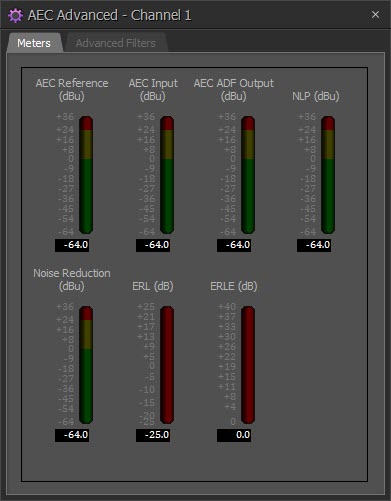
Custom Control Dialog
The Custom Mode allows users to tune the room acoustic settings via the sub-blocks within the Parle Processing container.
Parlé Processing with 2 Channels in Custom mode:

Parlé Processing with AEC Ref:
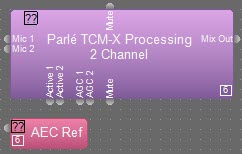
Parlé Processing with AEC Ref and AEC Input:
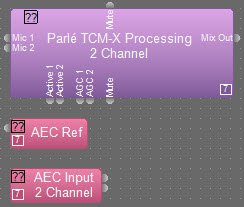
Signal flow for the Parlé Processing Block:

The sub-blocks within the Parlé Processing Block can be controlled from the corresponding Control Dialog. Double click on the sub-blocks to edit the settings:
